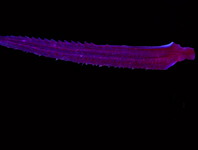Abstract
Miroculis Edmunds represents one of the most species-rich genera amongst Neotropical leptophlebiids comprising 25 valid species, with 18 of them reported from Brazil. Although several species have been described throughout the years, the taxonomy of Miroculis has focused mainly on male imagos, with other semaphoronts often unknown. Here, Miroculis (Miroculis) niltoi sp. nov. is described based on nymphs and imagos from Chapada Diamantina’s Complex, Northeast Brazil. Male imagos of M. (M.) niltoi sp. nov. can be distinguished by the styliger plate being medially cleft with a well-sclerotized ventrally-directed process at the posteromedial margin, while female imagos can be distinguished by the egg guide being well-developed, reaching sternum IX, and sternum IX about as long as wide, with a shallow apical cleft. Together with Miroculis (Miroculis) samba Costa, Almeida & Salles and Miroculis (Miroculis) wolverine Costa, Almeida & Salles, M. (M.) niltoi sp. nov. represents species within Miroculis with male imago exhibiting both extremely long penes and styliger plate. Now, Miroculis comprises 26 valid species, with 19 of them reported from Brazil.
References
Alkins-Koo, M. (1990) The aquatic fauna of two intermittent streams in the Southwestern Peninsula, Trinidad. Living World Journal of the Trinidad and Tobago Field Naturalists’ Club, 1989–1990, 36–42.
Barber-James, H.M., Gattolliat, J.-L., Sartori, M. & Hubbard, M.D. (2008) Global diversity of mayflies (Ephemeroptera, Insecta) in freshwater. Hydrobiologia, 595, 339–350.
https://doi.org/10.1007/s10750-007-9028-y
Barber-James, H.M., Sartori, M., Gattolliat, J.-L. & Webb, J. (2013) World checklist of freshwater Ephemeroptera species. World Wide Web electronic publication. Available from: http://fada.biodiversity.be/group/show/35 (accessed 10 February 2019)
Calor, A.R. & Mariano, R. (2012) UV light pan traps for collecting aquatic insects. Entomobrasilis, 5 (2), 164–166.
https://doi.org/10.12741/ebrasilis.v5i2.187
Costa, S.S. & Mariano, R. (2013) Description of a new species of Miroculis Edmunds, 1963 (Ephemeroptera: Leptophlebiidae) from Brazil. Zootaxa, 3599 (5), 495–498.
https://doi.org/10.11646/zootaxa.3599.5.7
Costa, V., Almeida, T.B. & Salles, F.F. (2019) Description of two related new species of Miroculis Edmunds, 1963 (Ephemeroptera: Leptophlebiidae) from Brazil and Colombia. Zootaxa, 4695 (3), 283–294.
https://doi.org/10.11646/zootaxa.4695.3.3
Domínguez, E. (2007) A new species of Miroculis (Ephemeroptera: Leptophlebiidae) from NE Argentina. Revista de la Sociedad Entomológica Argentina, 6 (3–4), 99–102.
Edmunds, G.F. (1963) A new genus and species of mayfly from Peru (Ephemeroptera: Leptophlebiidae). The Pan-Pacific Entomologist, 39 (1), 34–36.
Gama-Neto, J.L. & Hamada, N. (2013) A new species of Miroculis Edmunds, 1963 (Ephemeroptera, Leptophlebiidae) from northern Brazil. Zootaxa, 3734 (5), 597–600.
https://doi.org/10.11646/zootaxa.3734.5.9
Gama-Neto, J.L. & Hamada, N. (2014) Leptophlebiidae (Ephemeroptera) of the Serra do Tepequém, Roraima State, Brazil: new records and description of two new species. Zootaxa, 3900 (2), 279–286.
https://doi.org/10.11646/zootaxa.3900.2.8
Hubbard, M. (1995) Towards a standard methodology for the description of mayflies (Ephemeroptera). In: Corkum, L.D. & Ciborowski, J.J.H. (Eds.), Current Directions in Research on Ephemeroptera. Canadian Scholars’ Press, Toronto, pp. 361–369.
Juncá, F.A., Funch, L. & Rocha, W. (Eds.) (2005) Biodiversidade e conservação da Chapada Diamantina. Ministério do Meio Ambiente, Brasília, 411 pp.
Kluge, N. (2004) The Phylogenetic System of Ephemeroptera. Springer, Dordrecht, 442 pp.
https://doi.org/10.1007/978-94-007-0872-3
Lima, L.R.C., Raimundi, E.A., Pinheiro, U. & Salles, F.F. (2014) A new species of Miroculis Edmunds, 1963 (Ephemeroptera: Leptophlebiidae) from Northeastern Brazil. Zootaxa, 3795 (4), 441–448.
https://doi.org/10.11646/zootaxa.3795.4.4
Maury, C.M. (Ed) (2002) Biodiversidade brasileira. Ministério do Meio Ambiente, Brasília, 404 pp.
Meier, R. & Lim, G.S. (2009) Conflict, convergent evolution, and the relative importance of immature and adult characters in endopterygote phylogenetics. Annual Review of Entomology, 54 (1), 85–104.
https://doi.org/10.1146/annurev.ento.54.110807.090459
Peters, J.G., Domínguez, E. & Dereser, A.C. (2008) Species of Miroculis from the Serranía de Chiribiquete in Colombia. In: Hauer, F.R., Stanford, J.A. & Newell, R.L. (Eds.), University of California Publications in Entomology. Vol. 128. International Advances in the Ecology, Zoogeography and Systematics of Mayflies and Stoneflies. University of California Press, Los Angeles, California, pp. 295–305.
https://doi.org/10.1525/california/9780520098688.003.0019
Raimundi, E.A., Cabette, H.R.S., Brasil, L.S. & Salles, F.F. (2017a) A new species of Miroculis Edmunds, 1963 (Ephemeroptera: Leptophlebiidae) from Cerrado-Amazonian forest transition zone, Brazil. Zootaxa, 4299 (2), 271–278.
https://doi.org/10.11646/zootaxa.4299.2.7
Raimundi, E.A., Nascimento, J.M.C., Barroso, P.C.S., Hamada, N. & Boldrini, R. (2017b) Three new species of Miroculis from the Serra da Mocidade National Park, Roraima State, Brazil, with new records and checklist of the Leptophlebiidae (Ephemeroptera). Zootaxa, 4317 (3), 573–583.
https://doi.org/10.11646/zootaxa.4317.3.8
Rasband, W.S. (2018) ImageJ, U. S. National Institutes of Health. Bethesda, Maryland, USA. Available from: https://imagej.nih.gov/ij/ (accessed 12 July 2019)
Salles, F.F., Domínguez, E., Molineri, C., Boldrini, R., Nieto, C. & Dias, L.G. (2018) Order Ephemeroptera. In: Hamada, N., Thorp, J.H. & Rogers, D.C. (Eds.), Thorp and Covich’s Freshwater Invertebrates. 4th Edition. Keys to Neotropical Hexapoda. Academic Press, San Diego, California, pp. 61–117.
https://doi.org/10.1016/B978-0-12-804223-6.00003-2
Salles, F.F. & Lima, L.R.C. (2011) New species and records of Miroculis Edmunds (Ephemeroptera: Leptophlebiidae) from Southeastern Brazil. Zootaxa, 2740 (1), 53–58.
https://doi.org/10.11646/zootaxa.2740.1.5
Savage, H.M. & Peters, W.L. (1983) Systematics of Miroculis and related genera from Northern South America (Ephemeroptera: Leptophlebiidae). Transactions of the American Entomological Society, 108 (4), 491–600.
Savage, H.M. (1983) Wing evolution within Miroculis and related genera (Ephemeroptera: Leptophlebiidae) from northern South America. Journal of Zoological Systematics and Evolutionary Research, 21 (2), 124–141.
https://doi.org/10.1111/j.1439-0469.1983.tb00281.x
Savage, H.M. (1987) Two new species of Miroculis from Cerro de la Neblina, Venezuela with new distribution records for Miroculis fittkaui and Microphlebia surinamensis (Ephemeroptera: Leptophlebiidae). Aquatic Insects, 9 (2), 97–108.
https://doi.org/10.1080/01650428709361279
Velloso, A.L., Sampaio, E.V.S.B. & Pareyn, F.G.C. (Eds.) (2002) Ecorregiões propostas para o bioma Caatinga. Instituto de Conservação Ambiental The Nature Conservancy do Brasil, Recife, 75 pp.

